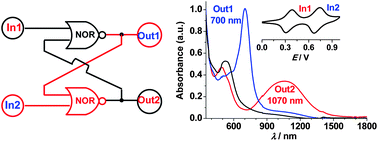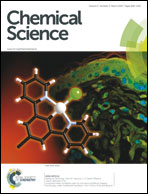Electropolymerized films as a molecular platform for volatile memory devices with two near-infrared outputs and long retention time†
Abstract
Surface-confined molecular logic gates have great potential as memory devices. We present in this article the uses of electropolymerized films as a molecular platform for volatile memory devices. A vinyl-substituted cyclometalated ruthenium–amine hybridized compound has been polymerized by reductive electropolymerization. The resulting polymeric films display two well-defined redox processes at +0.32 and +0.68 V vs. Ag/AgCl, leading to three well-separated redox states. Characterizations of these films by XPS and TEM techniques are presented. The singly- and doubly-oxidized states of the film possess intense absorption at 1070 and 700 nm, respectively. These polymeric films exhibit promising three-stage near-infrared electrochromism and the best contrast ratios (ΔT%) of 52% at 1070 nm and 76% at 700 nm have been achieved. The colors of the film at three redox stages are purple, brown, and sky blue, respectively. The electrochromism is featured by a long retention time at all three stages (infinity at −0.20 V, 4 h at +0.55 V, and 30 min at +1.05 V, respectively). The singly- and doubly-oxidized states of a film about 10 nm thick have been used to build a surface-confined Set/Reset flip-flop memory with two electrochemical inputs and two near-infrared optical outputs. By using another intermediate state between the singly- and doubly-oxidized states a multi-valued logic system has been demonstrated.


 Please wait while we load your content...
Please wait while we load your content...